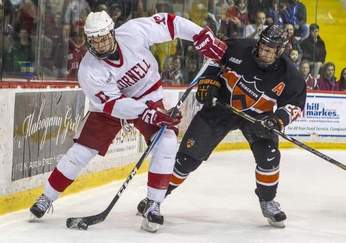Before WAFT looks forward and gets ahead of itself, we must look at Cornell's last weekend that was played at Lynah Rink. Few more disparate qualities of play from opponents could be brought to Lynah than those that Quinnipiac and Princeton offered. One opponent was tentative with poor passing, middling speed, puck handling, and stick handling. The other is not presently ranked first in the nation.
That was one of the many takeaways from observing the two teams that Cornell confronted last weekend. Princeton was confident and poised. The penalty kill for the Tigers was confident and quick. There was never a restful stick and nary a shooting lane to exploit. Where Princeton was crisp and smooth, Quinnipiac was shockingly rough and lacking in basic fundamentals. Quinnipiac passes missed their targets with relative frequency and several times Bobcat forwards missed relatively wide-open nets that Iles would have needed to make impossible saves to prevent a goal for the visitors.
We at WAFT cannot speak for Quinnipiac's quality of play when it began its impressive and active unbeaten streak. However, the dearth of soundness in the rudimentary elements of the game was in a word shocking for a team whose coaches, players, fans, and boosters claim deserved and received this week the nation's top spot in the most recent polls from coaches and media.
How can these criticisms withstand the disappointing 4-1 loss that Cornell suffered at the hands of the Bobcats? Hockey is played with six men on the ice per team and the Bobcats' sixth was more than equal to all but one of the challenges that Cornell presented. Quinnipiac's Hartzell recorded a 0.960 save percentage against Cornell at Lynah Rink on Saturday to earn the second-ever regular-season win for the Bobcats at Lynah. Hartzell elevated his game from an average 0.936 save percentage to garner the win in one of college hockey's historic building.
Quinnipiac played with a foolhardy hubris throughout the game. Many commentators who follow the ECAC have verified that this trend is far from a one-time occurrence. Cornell was unable to check the visitors's attitudes as a shot from the point from Clay Harvey through heavy traffic beat Iles and gave the Bobcats a lead that they would not relinquish. Cornell did not score until nearly the 58th minute of the game. It would be the only goal that Cornell scored all weekend.
Cornell's effort against Quinnipiac was solid, but it was not sufficient. Despite surrendering two even-strength goals (a power-play goal and an empty-net goal account for the other two totals for the Bobcats), Cornell's main shortcoming was a lack of goal scoring. The problem has plagued Cornell for weeks since the second half of the season began. Only twice since then has Cornell scored more than two goals. One of those games was a loss.
Hartzell may have been equal to the task of warding off a potent Cornell offense that generated appreciable offense with only minor opposition from Quinnipiac's defense. Cornell missed on opportunities from the point and dirty goals as Cornell gained a net-front presence often without much resistance. Cornell's lone goal was in fact a dirty goal from leading scorer senior Greg Miller. Nonetheless, Cornell did not score until the game was all but decided.
Princeton immediately appeared just as fast as it had been under Guy Gadowsky. If the team had lost any speed, it was not readily apparent. The Tigers were crisp and fluid. Their penalty-kill unit was confident, left little open ice, and had a fluidity with which it fought for and gained pucks pursuant to clearing Princeton's defensive zone that demonstrated to onlooking fans why Princeton has one of the best penalty-killing units in the nation this season.
The lone goal of the game is somewhat disappointing. Both teams played phenomenal games. Both teams were sound in their efforts from fundamentals to systemics. Few lapses were present for either team. The goal that beat Iles was a result of a fluke occurrence of events and it is sad that such a sequence decided the game.
Princeton's Ammon sprinted down the ice with the puck less than a minute into the second period. Ammon took a hard shot. The puck struck the glass behind Cornell's net loudly then bounced onto Iles's back and banked into the net.
Cornell had the balance of play and control of the game for all but the first four minutes of the second period. Princeton had clearly lost control of the game when Princeton left the ice after the first period. It is to Prier's credit that during the intermission he had his team ready to compete in a game that appeared to be slipping away. Had he not re-inspired his Tigers, the flukey goal that led to Princeton's victory may never have occurred.
An inopportune penalty against senior captain Erik Axell with 1:46 remaining in the game would have seemed to relinquish the remaining momentum to Princeton. Cornell was undeterred. Schafer consulted with his team during a timeout. The Big Red won the face-off and Iles raced to the bench alongside the offensive rush. Cornell generated several opportunities with senior captain D'Agostino splitting defenders as he brought the puck into the zone. Condon was committed to the right post leaving a wide-open net for Cornell.
Cornell would not convert to push the game into overtime. Several missed chances including two from scrums in front of the net would not yield goals.
There were upsides to the weekend. Cornell was penalized over the entire weekend with the same number of penalties with which it was punished in a single game in the North Country. Now, as previous weeks have shown, an improvement in one weekend does not indicate the beginning of a positive trend necessarily. One can hope.
Cornell continued to have a disciplined and successful penalty kill. Cornell killed off 85.7% of the power plays that its feline opponents enjoyed over last weekend.
Coach Schafer has reiterated many times that Cornell is at its best when its defensemen are jumping into offensive play responsibly. He said this within the last few weeks when discussing what would make this Cornell team ready to make a run to an ECAC Championship. D'Agostino and Ryan over the last two weekends have increased their offensive generations and the team has been the better for it.
Cornell has generated sufficient offense to win every game that it has lost since its last triumph against Union. Cornell has not converted. At this point the continuance of this problem is likely as much a product of psychology as it is strategy. No matter what, it is cause for concern at this late stage in the season. The alarms need to start sounding because it will be hard for Cornell to make a deep run into any round of the playoffs with scoring two or fewer goals per game. Iles regained much of his form this past weekend, but holding each opponent to a shutout or one goal is a lot to ask of even a goalie and defensive core as talented as those donning carnelian and white this season at the top of their game.
Before the ultimate descent into hysterics or hyperventilation (whichever tactic one may prefer), perhaps an embrace of a macabre sense of humor regarding our recent lull in goal scoring is appropriate. Coach Schafer said recently after this weekend's games that "it’s to the point where it’s almost comical, that you could generate that many scoring chances and get that many opportunities and not score."
While we ride out this goal-scoring drought one of our followers on twitter suggested some self-deprecating humor. The Sonic Insurgency suggested that we should take a page out of the playbook from Aston Villa's fans in the Premier League. It is shared below for your enjoyment.




 RSS Feed
RSS Feed
